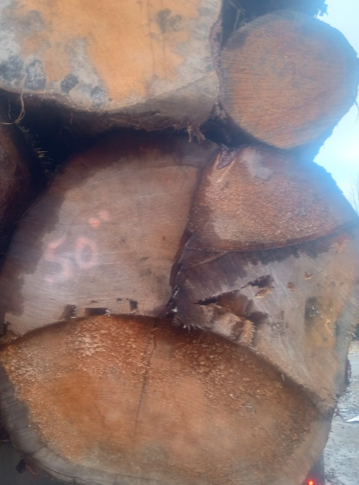I’m sure the denials will be numerous and certain but it’s an open secret there are mountains of top quality sawlogs decked at the PG Saw chip plant for chipping.
One source, who I can’t name, sent me a photo of one log, 50 inches in diameter, solid, and pushing 300 years old, being hauled out of the McGregors to the chip plant.
It’s one of those things nobody likes to talk about. Whenever there is a shortage of low quality “pulp logs” to make pulp and paper, we simply use top-grade sawlogs, much of it irreplaceable old growth, to make our disposable paper products.
It’s totally legal and as long as the price of pulp sustains it, it will happen.
The problem has grown worse with the shutdown of local mills like Polar in Bear Lake.
Polar had a giant band saw headrig that used to chew through oversize logs up to 60 inches in diameter. With that mill shut down, not only has the chip supply been reduced, but oversize logs have nowhere to go other than the button-top splitter and chipper. And if we want the pulp mills to keep running, chips have to come from somewhere.
It’s almost like Canfor foresaw the problem. A few years ago they did a major upgrade to their log-chipping facility at PG Saw to chip small-diameter logs. But instead of running those small-diameter logs, it is now busy hogging down big logs just in time to alleviate the chip supply constraints imposed by the shutdown of regional sawmills from Houston through to Isle Pierre.
In a way the industry has come full circle. In its dying days we are back to where the pulp mills started: Chipping grade A sawlogs and old growth.
It’s nevertheless a pretty harsh insult to the public after we gave the pulp mills tens of millions of public dollars to help them get actual pulp logs last year. I guess we need to spend another $50 million to get them more.
There’s a better option. We start thinning the plantations.
Instead of feeding the pulp mills old-growth gold, we feed them plantation pine.
For some reason the government is preventing this.
For some reason, going into the 30-year-old plantations and thinning out the dense pine for pulp and sawlog to improve wildlife, wildfire resilience and log quality, something the Scandinavians and Germans have been doing for centuries, is not something the government wants to encourage.
From what I understand the government thinks thinning young conifer plantations will delay how quickly a plantation can achieve its maximum rate of growth, or the mean annual increment (MAI) measurement.
In layman's terms, the government’s faulty Vegetative Resource Inventory (VRI), which is consistently underestimating plantation growth, says thinning stands will cause a slight reduction in the annual allowable cut.
There is reason to be skeptical of this.
The ministry may think yield projection models are gospel. But they are only as good as the VRI data that feeds it. And chipping up sawlogs instead of spindly pines is a big price to pay for out-of-date data and bureaucratic bull-headedness.
Thinning out the plantations can save our old-growth from the chipper, can save our pulp mills from the dustbin, and a big one for me is it can open up dense, lifeless plantations, many of them previously sprayed with glyphosate, to get some fire-resistant aspen and birch growing and much-needed habitat and biodiversity for our wildlife and moose.
Let's hope new Forest Minister Ravi Parmar gets on this topic early and hard. The only thing preventing this win-win scenario is bureaucratic commitment to the broken status quo.
James Steidle is a Prince George writer.



